PICASSO
Planetary Instrument Concepts for the Advancement of Solar System Observations (PICASSO)
The PICASSO program is funding the development of instruments to accomplish future science missions across the Solar System. The two tables below show the applicability of the funded instruments to science goals as described by the Planetary Science Decadal Study, and by instrument type.
| PICASSO Instruments Address Decadal Science Themes | Jupiter, Saturn, Uranus, Neptune | Europa, Enceladus, Ganymede, Callisto | All planetary bodies | |||||||||||||
| Themes | Priority Questions | Relevant Measurement Capabilities | Mercury | Venus | The Moon | Mars | Asteroids, Trojans, KBOs, NEOs | Comets | Gas Giants | Titan | Icy Moons | Other gas giant moons and rings | With atmosphere | Without atmosphere | Other | |
| Building New Worlds | What were the initial stages, conditions, and processes of solar system formation and the nature of the interstellar matter that was incorporated? | Mineralogy (alteration history) |
P18-013 P16-003 P15-058 P15-071 |
P18-013 P16-003 P15-058 P15-071 |
P16-003 P15-071 |
|||||||||||
| Organic chemistry (traceability to ISM reaction pathways) |
P18-013 P18-106 P16-075 P15-022 |
P18-013 P18-106 P15-016 P15-022 |
||||||||||||||
| Geochronology (age dating of planetary body) |
P16-090 P16-096 |
|||||||||||||||
| Compositional mapping (global bulk chemistry) |
P17-021 P17-025 P17-037 P17-048 P15-058 P15-071 |
P18-031 P18-056 P17-021 P17-025 P17-037 P17-048 P16-054 P15-058 P15-071 |
P15-071 | |||||||||||||
| How did the giant planets and their satellite systems accrete, and is there evidence that they migrated to new orbital positions? | Magnetometry (e.g., Dynamo orientation) | |||||||||||||||
| Mineralogy (e.g., chemistry consistent with different orbital position) | P18-013 P15-058 P15-071 |
P18-013 P15-058 P15-071 |
P18-013 P15-058 |
P18-013 P15-058 P15-071 |
P18-013 | P15-071 | ||||||||||
| What governed the accretion, supply of water, chemistry, and internal differentiation of the inner planets and the evolution of their atmospheres, and what roles did bombardment by large projectiles play? | Isotopic chemistry (e.g., atmospheric/exospheric signatures, trapped volatiles, signatures of atmosphere-surface interactions) |
P18-076 P17-021 P17-025 P17-037 P17-048 P17-083 P15-009 P15-010 P15-058 |
P18-003 P17-021 P17-025 P17-037 P17-048 P17-083 P15-058 |
P18-003 P17-021 P17-025 P17-037 P17-048 P17-083 P17-094 P16-055 P16-078 P15-009 P15-010 P15-052 P15-058 |
P18-003 P17-021 P17-025 P17-037 P17-048 P17-083 P15-052 P15-058 |
P18-003 P17-021 P17-025 P17-037 P17-048 P17-083 P16-054 P15-009 P15-052 P15-058 |
||||||||||
| Interior structure (e.g., seismic activity) | P17-021 P15-093 |
P17-021 P15-093 |
P16-002 | P16-002 | ||||||||||||
| Geology (imaging) | P16-012 P16-074 |
P17-021 P16-012 |
P16-012 P15-053 |
P16-012 P15-053 |
P16-012 P15-053 |
|||||||||||
| Planetary Habitats | What were the primordial sources of organic matter, and where does organic synthesis continue today? | Mineralogy (alteration history) | P18-013 P16-012 P15-058 |
P18-013 P17-021 P16-012 P15-058 |
P18-013 P17-021 P16-012 P15-058 |
P15-058 | P16-012 P15-058 P15-071 |
|||||||||
| Organic chemistry (traceability to known reaction pathways) | P18-013 P18-106 P16-012 P16-055 P16-078 P15-022 |
P18-013 P18-106 P16-012 P16-075 P15-022 |
P18-013 P18-106 P16-012 P15-022 |
P18-106 P16-078 P16-075 P15-016 |
P18-106 P16-012 P16-075 P16-078 P16-055 P15-016 |
P16-032 | P16-032 | |||||||||
| Compositional mapping (global bulk chemistry) | P17-025 P16-012 P15-071 |
P18-031 P18-056 P17-025 P16-012 P15-071 |
P18-031 P18-056 |
P18-031 P18-056 P16-012 P15-071 |
P16-032 | P16-032 P15-071 |
||||||||||
| Sample acquisition (subsurface environments) | P16-078 | P16-003 P15-071 |
P16-003 P15-071 |
P16-078 | P16-078 P15-071 |
P16-003 P15-071 |
||||||||||
| Did Mars or Venus host ancient aqueous environments conducive to early life, and is there evidence that life emerged? | Mineralogy (alteration history) | P18-013 P16-012 |
P18-013 | |||||||||||||
| Organic chemistry (traceability to ISM reaction pathways) | P16-032 P16-012 P15-022 P15-022 |
P18-003 P18-013 P18-106 P16-032 P16-055 P15-022 P15-062 |
||||||||||||||
| Compositional mapping (global bulk chemistry) | P16-032 P16-012 |
P16-032 | ||||||||||||||
| Isotopic chemistry (e.g., atmospheric signatures, trapped volatiles, signatures of atmosphere-surface interactions) | P18-076 P16-044 |
P18-003 P16-078 P15-052 |
||||||||||||||
| Interior structure (e.g., seismic activity) | P17-029 P15-079 |
P18-036 P17-029 P15-079 P15-093 |
||||||||||||||
| Geology (imaging) | P18-047 P16-012 P16-074 |
P16-012 P15-053 |
||||||||||||||
| Sample acquisition (subsurface environments) |
P16-012 | P16-078 P16-012 |
||||||||||||||
| Beyond Earth, are there modern habitats elsewhere in the solar system with necessary conditions, organic matter, water, energy, and nutrients to sustain life, and do organisms live there now? | thermal mapping (hotspots, plumes, recent geologic activity) |
P15-022 | P15-022 | P15-022 | ||||||||||||
| Mineralogy (alteration history) | P18-013 P16-012 |
P18-013 | P18-013 P16-012 P15-071 |
P15-071 | ||||||||||||
| Organic chemistry (traceability to prebiotic pathways, potential biochemistry) | P18-003 P18-013 P18-027 P18-106 P17-037 P16-012 P16-055 P15-016 P15-062 |
P18-003 P18-013 P18-027 P18-106 P17-058 P17-037 P15-016 P15-062 |
P18-003 P18-013 P18-027 P18-106 P17-058 P17-037 P16-012 P16-055 P16-075 P15-016 P15-062 |
P16-032 | P16-032 | |||||||||||
| Compositional mapping (global bulk chemistry) | P16-012 P15-052 |
P15-052 | P16-012 P16-054 P15-052 P15-071 |
P16-032 | P16-032 P15-071 |
|||||||||||
| Isotopic chemistry (e.g., atmospheric/exospheric/plume signatures, trapped volatiles, signatures of atmosphere-surface interactions) | P18-003 P17-037 P16-078 P15-022 |
P18-003 P18-076 P17-037 P16-078 P15-022 |
P18-003 P17-037 P16-078 P16-054 P15-022 |
|||||||||||||
| Interior structure and gravity (e.g., ice thickness and structure, identification of subsurface reservoirs and/or oceans) | P18-036 P18-073 P17-021 P17-029 P16-015 P15-079 |
P18-036 P18-073 P15-100 |
P18-036 P18-073 P16-004 P15-100 |
|||||||||||||
| Geology (imaging, evidence for present-day activity) | P16.012 P15-053 |
P15-053 | P16-012 P15-053 |
P16-032 | P16-032 P15-071 |
|||||||||||
| Sample acquisition (subsurface environments) | P16-078 P16-012 |
P16-078 | P16-012 P16-078 |
P16-003 | ||||||||||||
| Workings of solar systems | How do the giant planets serve as laboratories to understand Earth, the solar system, and extrasolar planetary systems? | Isotopic chemistry (e.g., atmospheric/exospheric/plume signatures, trapped volatiles, signatures of atmosphere-surface interactions) | P18-031 P18-056 P18-076 P17-025 P16-044 P15-009 |
|||||||||||||
| Compositional mapping (global bulk chemistry) | P18-031 P18-056 P18-076 P15-071 |
P15-071 | ||||||||||||||
| Magnetometry (e.g., Dynamo orientation) | P15-100 | |||||||||||||||
| Imaging of ring and satellite dynamics | P15-022 | |||||||||||||||
| What solar system bodies endanger Earth’s biosphere, and what mechanisms shield it? | Magnetometry (e.g., magnetosphere structure) | P16-040 P15-100 P15-022 |
P16-040 P15-100 P15-022 |
P16-040 P15-100 P15-022 |
P16-040 P15-100 P15-022 |
|||||||||||
| Imaging, characterization of near-Earth objects | P15-022 | P15-022 | P15-022 | P16-074 P15-022 |
||||||||||||
| Particles and Fields (intersection with heliophysics, space weather) | P16-040 P15-071 P15-022 |
P16-040 P15-071 P15-022 |
P16-040 P15-071 P15-022 |
P16-040 P15-071 P15-022 |
P15-071 | P15-071 | ||||||||||
| Can understanding the roles of physics, chemistry, geology, and dynamics in driving planetary atmospheres and climates lead to a better understanding of climate change on Earth? | atmospheric chemistry/dynamics at Venus, Mars (e.g., profile measurements from probe) | P18-047 P18-076 P17-021 P17-025 P17-030 P17-037 P17-048 P17-083 P16-044 P15-009 P15-010 P15-022 |
P17-021 P17-025 P17-037 P17-048 P17-083 P15-009 P15-010 P15-022 |
P18-076 P17-025 P17-030 P16-044 P16-074 P15-009 P15-022 |
P18-076 P17-021 P17-025 P17-030 P17-037 P17-048 P17-083 P15-009 P15-010 P15-022 |
|||||||||||
| Geology (imaging) | P18-033 | P17-126 P15-053 |
P17-126 | |||||||||||||
| Compositional mapping (global bulk chemistry) | P15-058 | P15-058 | P15-058 | P15-058 | ||||||||||||
| surface chemistry | P17-025 P16-005 P15-052 |
P15-052 | ||||||||||||||
| sample acquisition (subsurface environments) | P17-094 | |||||||||||||||
| Interior structure and gravity (e.g., seismic activity, subsurface volatile reservoirs) | P17-029 P16-074 P15-079 |
P17-021 P17-029 P15-079 P15-093 |
P17-021 P17-029 P15-079 |
P15-093 | ||||||||||||
| Mineralogy (planetary evolution) | ||||||||||||||||
| Magnetometry (e.g., magnetosphere structure) | P16-040 P15-022 |
P16-040 P15-022 |
P16-040 P15-022 |
P16-040 P15-022 |
||||||||||||
| How have the myriad chemical and physical processes that shaped the solar system operated, interacted, and evolved over time? | atmospheric chemistry/dynamics (e.g., profile measurements from probe) | P15-022 | P18-047 P18-076 P17-030 P17-037 P16-044 P15-009 P15-010 P15-022 |
P15-022 | P17-037 P15-009 P15-010 P15-022 |
P15-022 | P15-009 P15-022 |
P18-076 P17-025 P17-030 P17-037 P16-044 P16-074 P15-009 P15-022 |
P18-031 P18-056 P18-076 P17-025 P17-030 P17-037 P15-009 P15-010 P15-022 |
P18-031 P18-056 P15-022 |
P18-031 P18-056 P15-022 |
P17-025 P17-030 P17-037 P15-022 |
||||
| Geology (imaging) | P18-047 | P18-047 | P17-089 P17-126 P15-053 |
P17-089 P17-126 P15-053 |
P17-089 P15-053 |
P17-089 P15-053 |
P17-126 P15-053 |
P15-053 | P16-074 | |||||||
| Compositional mapping (global bulk chemistry) | P15-071 | P15-058 | P17-089 P15-058 P15-071 |
P17-089 P15-058 |
P17-089 P15-058 P15-071 |
P17-089 P15-058 P15-071 |
P15-071 | P15-058 | P15-058 P15-071 |
P15-058 P15-071 |
P15-071 | |||||
| surface chemistry | P15-071 | P17-109 P16-090 P16-096 P15-052 P15-071 |
P17-109 P16-005 P16-096 P16-090 |
P17-109 P16-090 P16-096 P16-101 P15-052 P15-071 |
P17-109 P15-052 P15-071 |
P15-071 | P17-109 P15-052 |
P17-109 P15-052 P15-071 |
P17-109 P16-101 P15-071 |
P15-071 | ||||||
| sample acquisition (subsurface environments) | P17-094 | P17-089 | ||||||||||||||
| Interior structure and gravity (e.g., seismic activity, subsurface volatile reservoirs) | P17-021 P17-029 |
P17-029 P16-074 P15-079 |
P18-036 P18-073 P17-021 P17-029 P16-015 P15-093 |
P18-036 P18-073 P17-021 P17-029 P16-015 P15-079 P15-093 |
P17-021 P16-002 |
P16-002 | P18-036 P18-073 P17-021 P17-029 P15-079 |
P18-036 P18-073 P17-021 P17-029 P16-004 |
P18-036 P18-073 P17-029 P16-074 |
P15-093 | ||||||
| Mineralogy (planetary evolution) | P15-071 | P18-013 | P18-013 P15-071 |
P18-013 P15-071 |
P18-013 P15-071 |
P15-071 | P18-013 | P18-013 P15-071 |
P18-013 P15-071 |
P15-071 | ||||||
| Magnetometry (e.g., magnetospheic dynamics) | P16-040 | P16-040 | P16-040 | P16-040 | P16-040 | P16-040 | P16-040 | P16-040 | P16-040 | P16-040 | ||||||
| Imaging, characterization of near-Earth objects | P17-089 | |||||||||||||||
Martian Anemometer
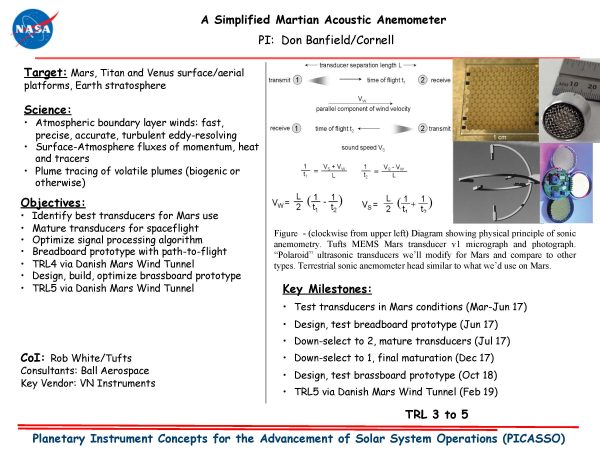 A Simplified Martian Acoustic Anemometer
A Simplified Martian Acoustic Anemometer
Mars, Titan and Venus surface/aerial platforms, Earth stratosphere
Polarization Nephelometer
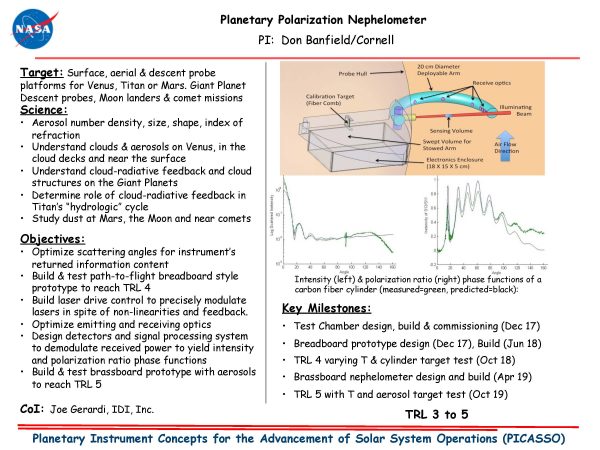 Planetary Polarization Nephelometer
Planetary Polarization Nephelometer
Surface, aerial & descent probe platforms for Venus, Titan or Mars. Giant Planet Descent probes, Moon landers & comet missions
Martian Dust
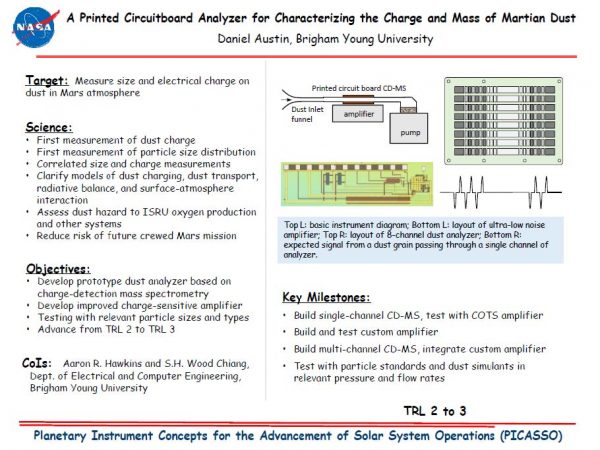 A Printed Circuitboard Analyzer for Characterizing the Charge and Mass of Martian Dust
A Printed Circuitboard Analyzer for Characterizing the Charge and Mass of Martian Dust
Measure size and electrical charge on dust in Mars atmosphere
Organic Detection
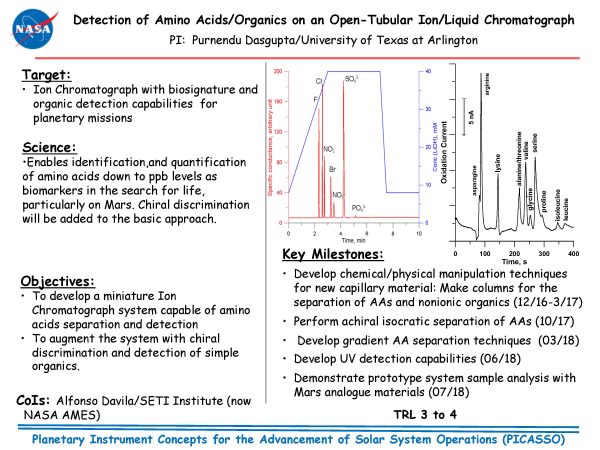 Detection of Amino Acids/Organics on an Open-Tubular Ion/Liquid Chromatograph
Detection of Amino Acids/Organics on an Open-Tubular Ion/Liquid Chromatograph
Ion Chromatograph with biosignature and organic detection capabilities for planetary missions
Surface Compositions
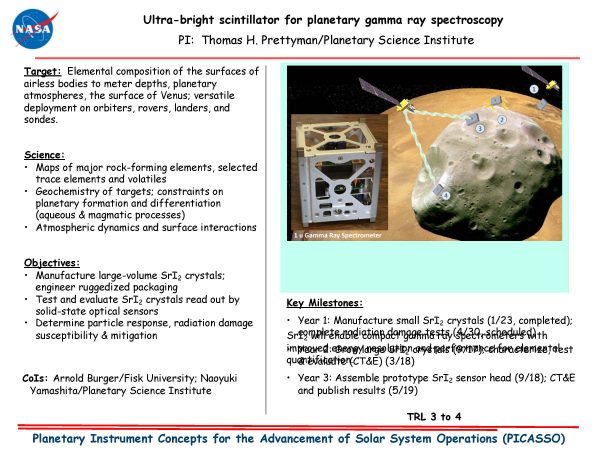 Ultra-bright scintillator for planetary gamma ray spectroscopy
Ultra-bright scintillator for planetary gamma ray spectroscopy
Elemental composition of the surfaces of airless bodies to meter depths, planetary atmospheres, the surface of Venus; versatile deployment on orbiters, rovers, landers, and sondes.
Gravity Measurements
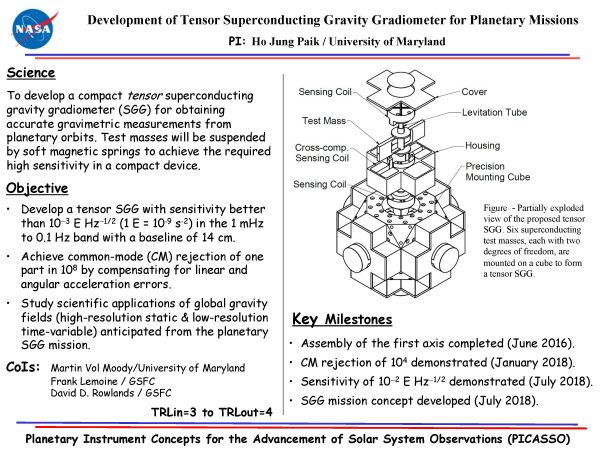 Development of Tensor Superconducting Gravity Gradiometer for Planetary Missions
Development of Tensor Superconducting Gravity Gradiometer for Planetary Missions
To develop a compact tensor superconducting gravity gradiometer (SGG) for obtaining accurate gravimetric measurements from planetary orbits. Test masses will be suspended by soft magnetic springs to achieve the required high sensitivity in a compact device.
High Temperature Electronics
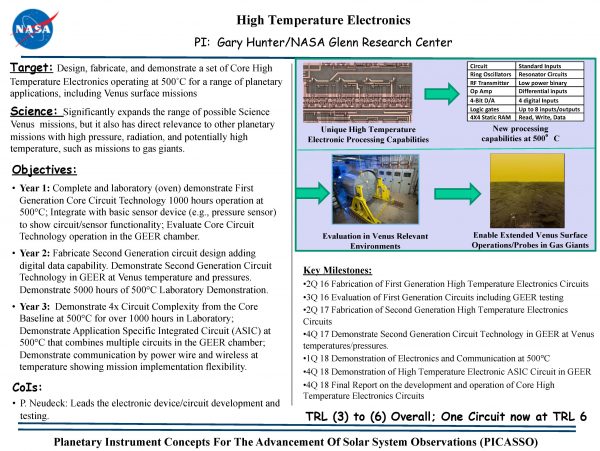 High Temperature Electronics
High Temperature Electronics
Design, fabricate, and demonstrate a set of Core High Temperature Electronics operating at 500˚C for a range of planetary applications, including Venus surface missions
Venus Interior
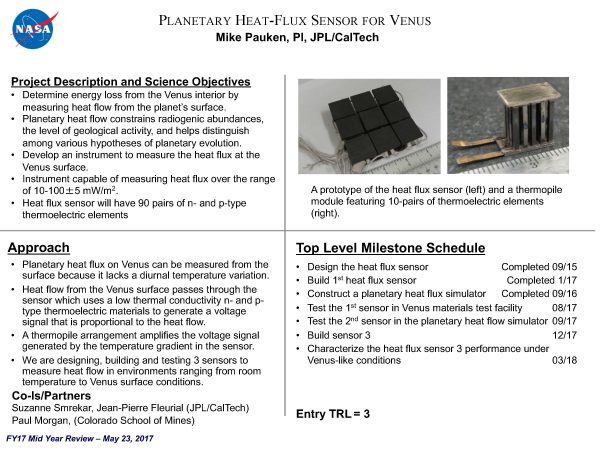 Planetary Heat-Flux Sensor for Venus
Planetary Heat-Flux Sensor for Venus
Determine energy loss from the Venus interior by measuring heat flow from the planet’s surface.
Planetary heat flow constrains radiogenic abundances, the level of geological activity, and helps distinguish among various hypotheses of planetary evolution.
-
- Develop an instrument to measure the heat flux at the Venus surface.
- Instrument capable of measuring heat flux over the range of 10-100±5 mW/m2.
- Heat flux sensor will have 90 pairs of n- and p-type thermoelectric elements
Infrared Imager
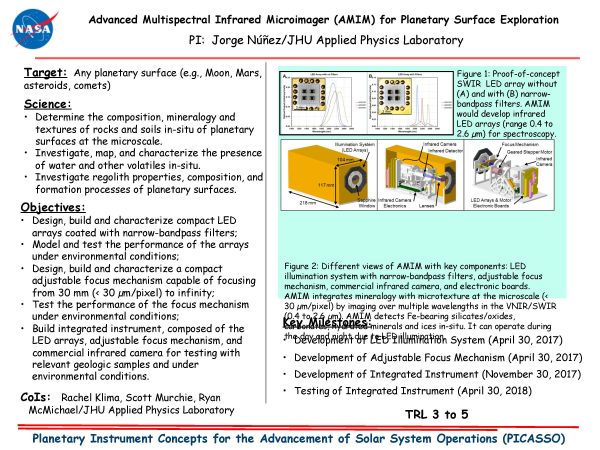 Advanced Multispectral Infrared Microimager (AMIM) for Planetary Surface Exploration
Advanced Multispectral Infrared Microimager (AMIM) for Planetary Surface Exploration
Any planetary surface (e.g., Moon, Mars, asteroids, comets)
Atmospheric Gases
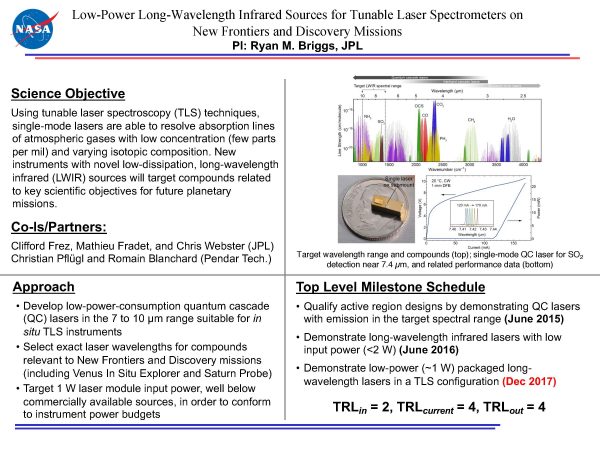 Low-Power Long-Wavelength Infrared Sources for tunable Laser Spectrometers on New Frontiers and Discovery Missions
Low-Power Long-Wavelength Infrared Sources for tunable Laser Spectrometers on New Frontiers and Discovery Missions
Using tunable laser spectroscopy (TLS) techniques, single-mode lasers are able to resolve absorption lines of atmospheric gases with low concentration (few parts per mil) and varying isotopic composition. New instruments with novel low-dissipation, long-wavelength infrared (LWIR) sources will target compounds related to key scientific objectives for future planetary missions.
Harsh Environment Magnetometer
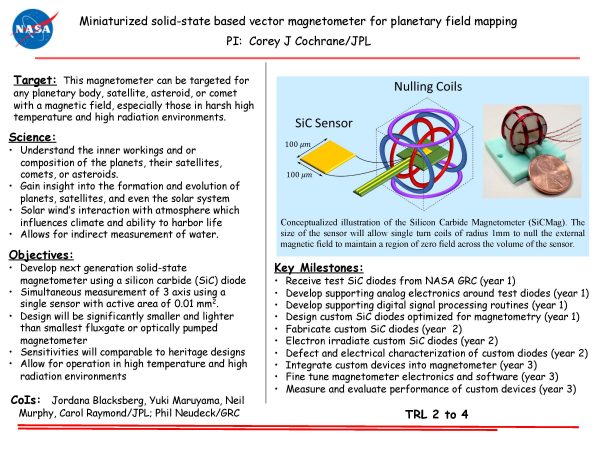 Miniaturized solid-state based vector magnetometer for planetary field mapping
Miniaturized solid-state based vector magnetometer for planetary field mapping
This magnetometer can be targeted for any planetary body, satellite, asteroid, or comet with a magnetic field, especially those in harsh high temperature and high radiation environments.
Magnetic Fields
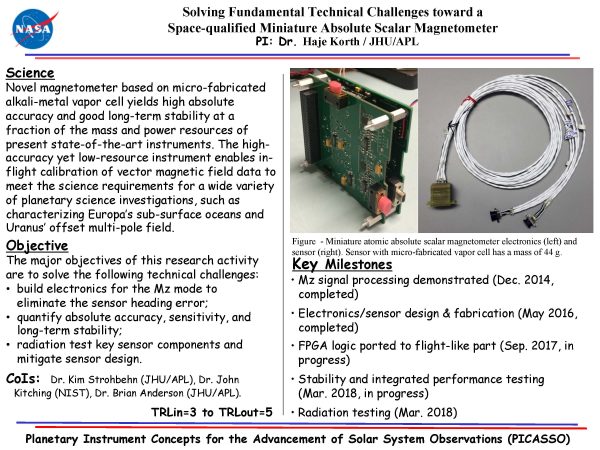 Solving Fundamental Technical Challenges toward a Space-qualified Miniature Absolute Scalar Magnetometer
Solving Fundamental Technical Challenges toward a Space-qualified Miniature Absolute Scalar Magnetometer
Novel magnetometer based on micro-fabricated alkali-metal vapor cell yields high absolute accuracy and good long-term stability at a fraction of the mass and power resources of present state-of-the-art instruments. The high-accuracy yet low-resource instrument enables in-flight calibration of vector magnetic field data to meet the science requirements for a wide variety of planetary science investigations, such as characterizing Europa’s sub-surface oceans and Uranus’ offset multi-pole field.
Organic Compounds
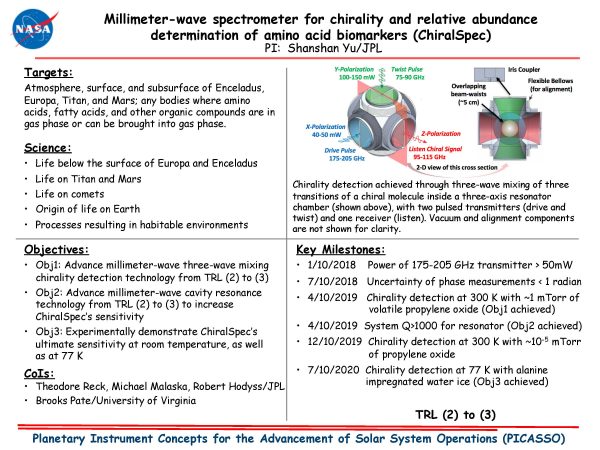 Millimeter-wave spectrometer for chirality and relative abundance determination of amino acid biomarkers (ChiralSpec)
Millimeter-wave spectrometer for chirality and relative abundance determination of amino acid biomarkers (ChiralSpec)
Atmosphere, surface, and subsurface of Enceladus, Europa, Titan, and Mars; any bodies where amino acids, fatty acids, and other organic compounds are in gas phase or can be brought into gas phase.
Neutron Detection
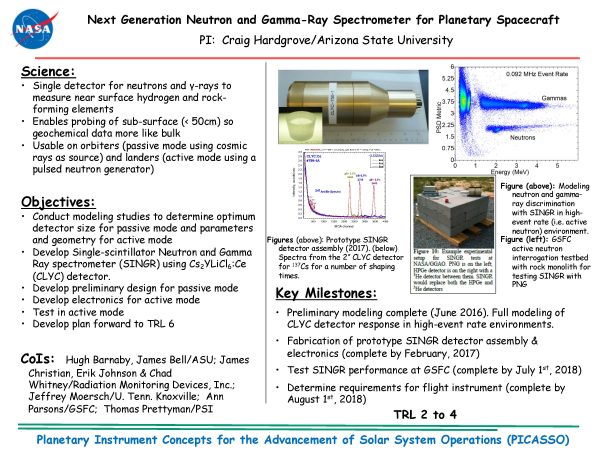 Next Generation Neutron and Gamma-Ray Spectrometer for Planetary Spacecraft
Next Generation Neutron and Gamma-Ray Spectrometer for Planetary Spacecraft
Single detector for neutrons and γ-rays to measure near surface hydrogen and rock-forming elements
Enables probing of sub-surface (< 50cm) so geochemical data more like bulk
Usable on orbiters (passive mode using cosmic rays as source) and landers (active mode using a pulsed neutron generator)
Space Plasma
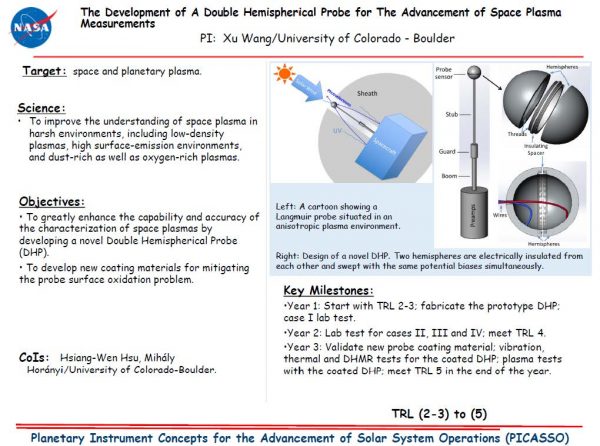 The Development of a Double Hemispherical Probe for the Advancement of Space Plasma Measurements
The Development of a Double Hemispherical Probe for the Advancement of Space Plasma Measurements
To improve the understanding of space plasma in harsh environments, including low-density plasmas, high surface-emission environments, and dust-rich as well as oxygen-rich plasmas
Organic Analysis
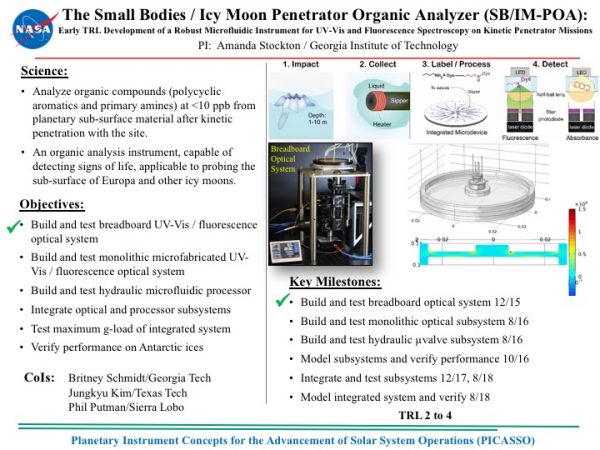 The Small Bodies/Icy Moon Penetrator Organic Analyzer (SB/IM-POA)
The Small Bodies/Icy Moon Penetrator Organic Analyzer (SB/IM-POA)
Analyze organic compounds (polycyclic aromatics and primary amines) at <10 ppb from planetary sub-surface material after kinetic penetration with the site.
An organic analysis instrument, capable of detecting signs of life, applicable to probing the sub-surface of Europa and other icy moons.
Minerals
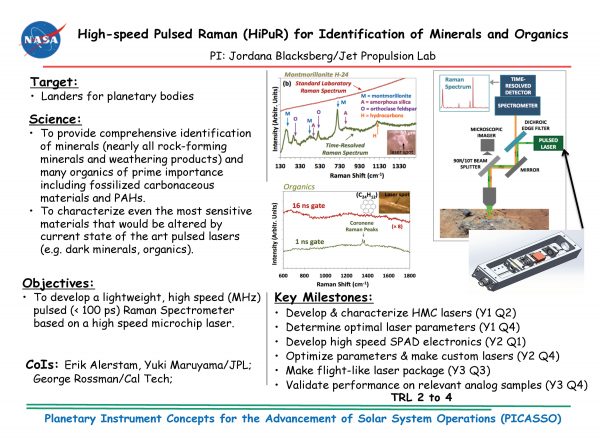 High-speed Pulsed Raman (HiPuR) for Identification of Minerals and Organics
High-speed Pulsed Raman (HiPuR) for Identification of Minerals and Organics
Landers for planetary bodies
Planetary Geology
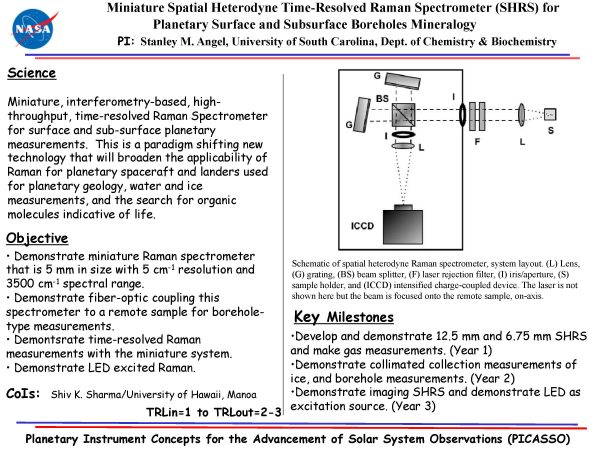 Miniature Spatial Heterodyne Time-Resolved Raman Spectrometer (SHRS) for Planetary Surface and Subsurface Boreholes Mineralogy
Miniature Spatial Heterodyne Time-Resolved Raman Spectrometer (SHRS) for Planetary Surface and Subsurface Boreholes Mineralogy
Miniature, interferometry-based, high-throughput, time-resolved Raman Spectrometer for surface and sub-surface planetary measurements. This is a paradigm shifting new technology that will broaden the applicability of Raman for planetary spaceraft and landers used for planetary geology, water and ice measurements, and the search for organic molecules indicative of life.
Atmospheric Descent
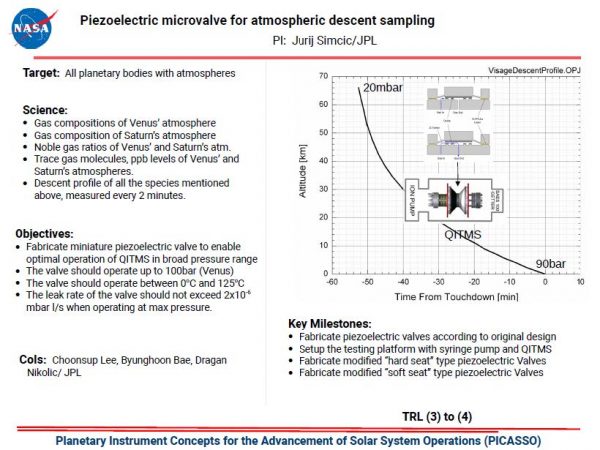 Plezoelectric microvalve for atmospheric descent sampling
Plezoelectric microvalve for atmospheric descent sampling
All planetary bodies with atmospheres
Mineralogy
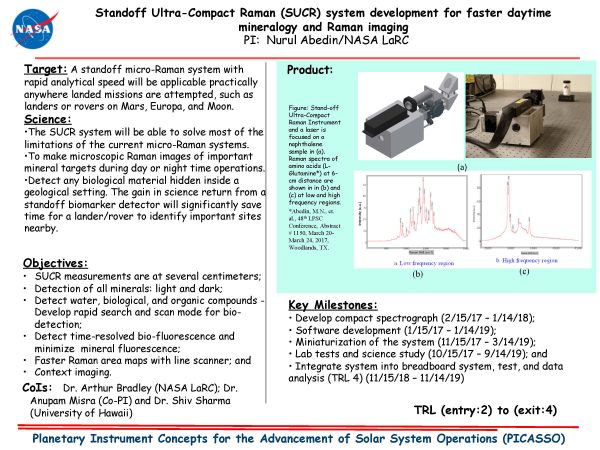 Standoff Ultra-Compact Raman (SUCR) system development for faster daytime mineralogy and Raman imaging
Standoff Ultra-Compact Raman (SUCR) system development for faster daytime mineralogy and Raman imaging
A standoff micro-Raman system with rapid analytical speed will be applicable practically anywhere landed missions are attempted, such as landers or rovers on Mars, Europa, and Moon.
Micro-Seismometer
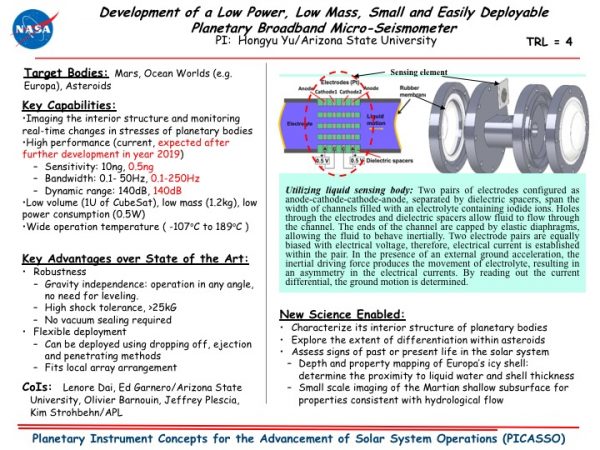 Development of a Low Power, Low Mass, Small and Easily Deployable Planetary Broadband Micro-Seismometer
Development of a Low Power, Low Mass, Small and Easily Deployable Planetary Broadband Micro-Seismometer
Mars, Ocean Worlds (e.g., Europa), Asteroids
Seismic Laser
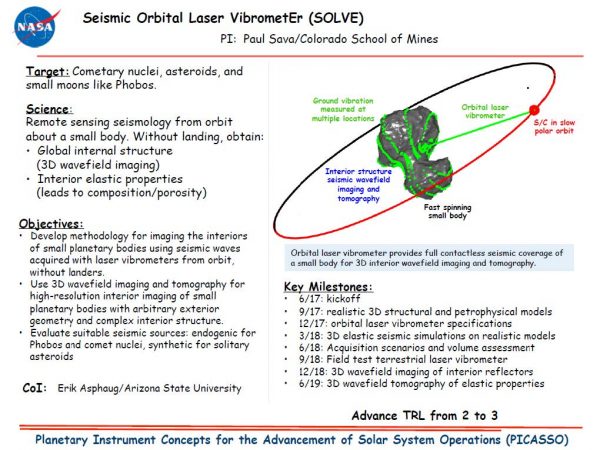 Seismic Orbital Laser VibrometEr (SOLVE)
Seismic Orbital Laser VibrometEr (SOLVE)
Cometary nuclei, asteroids, and small moons like Phobos
Spectroscopy
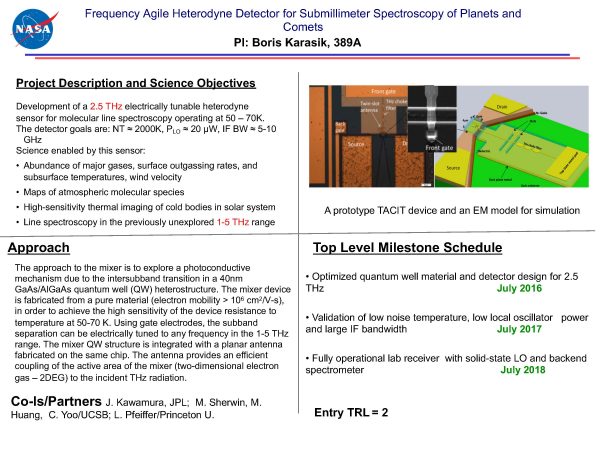 Frequency Agile Heterodyne Detector for Submillimeter Spectroscopy of Planets and Comets
Frequency Agile Heterodyne Detector for Submillimeter Spectroscopy of Planets and Comets
Development of a 2.5 THz electrically tunable heterodyne sensor for molecular line spectroscopy operating at 50 – 70K.
The detector goals are: NT ≈ 2000K, PLO ≈ 20 µW, IF BW ≈ 5-10 GHz
Science enabled by this sensor:
-
- Abundance of major gases, surface outgassing rates, and subsurface temperatures, wind velocity
- Maps of atmospheric molecular species
- High-sensitivity thermal imaging of cold bodies in solar system
- Line spectroscopy in the previously unexplored 1-5 THz range
Gas Spectrometer
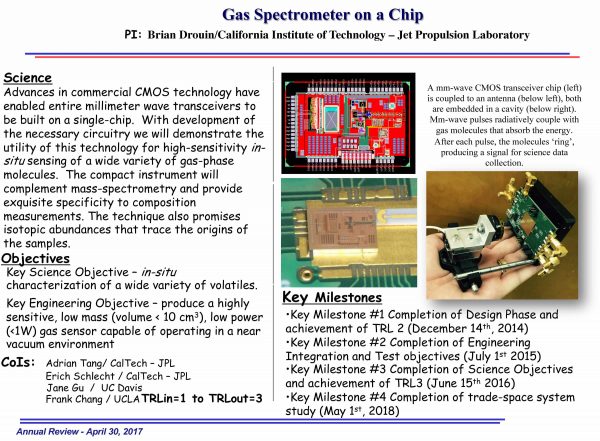 Gas Spectrometer on a Chip
Gas Spectrometer on a Chip
Advances in commercial CMOS technology have enabled entire millimeter wave transceivers to be built on a single-chip. With development of the necessary circuitry we will demonstrate the utility of this technology for high-sensitivity in-situ sensing of a wide variety of gas-phase molecules. The compact instrument will complement mass-spectrometry and provide exquisite specificity to composition measurements. The technique also promises isotopic abundances that trace the origins of the samples.
Trace Imager
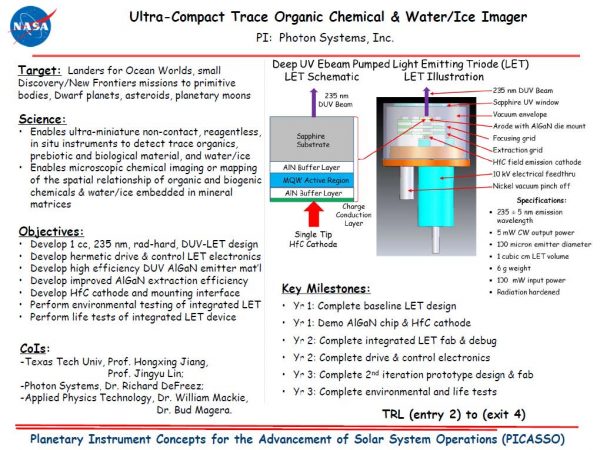 Ultra-Compact Trace Organic Chemical & Water/Ice Imager
Ultra-Compact Trace Organic Chemical & Water/Ice Imager
Landers for Ocean Worlds, mall Discovery/New Frontiers missions to primitive bodies, Dwarf planets, asteroids, planetary moons
Bio-detection
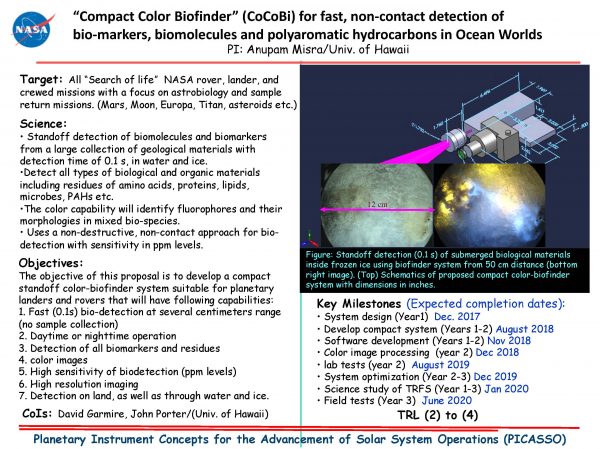 Compact Color Biofinder (CoCoBi) for fast, non-contact detection of bio-markers, biomolecules and polyaromatic hydrocarbons in Ocean Worlds
Compact Color Biofinder (CoCoBi) for fast, non-contact detection of bio-markers, biomolecules and polyaromatic hydrocarbons in Ocean Worlds
All “Search of life” NASA rover, lander, and crewed missions with a focus on astrobiology and sample return missions. (Mars, Moon, Europa, Titan, asteroids etc.)
X-Ray Spectrometer
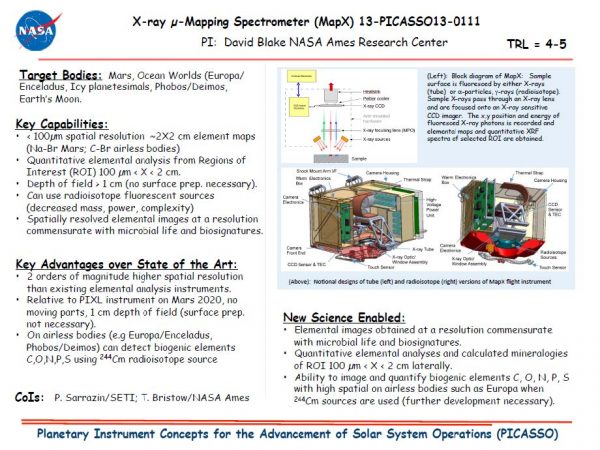 X-Ray µ-Mapping Spectrometer (MapX)
X-Ray µ-Mapping Spectrometer (MapX)
Mars, Ocean Worlds (Europa/Enceladus, Icy planetestimals, Phobos/Deimos, Earth’s Moon.
Surface Spectrometer
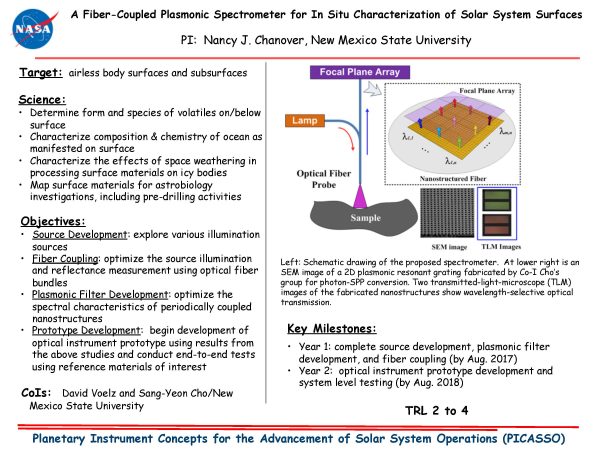 A Fiber-Coupled Plasmonic Spectrometer for In Situ Characterization of Solar System Surfaces
A Fiber-Coupled Plasmonic Spectrometer for In Situ Characterization of Solar System Surfaces
Airless body surfaces and subsurfaces
Electron Probe
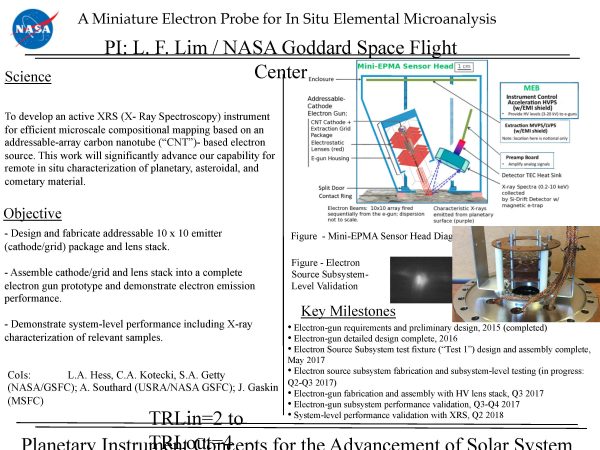 A Miniature Electron Probe for In Situ Elemental Microanalysis
A Miniature Electron Probe for In Situ Elemental Microanalysis
To develop an active XRS (X- Ray Spectroscopy) instrument for efficient microscale compositional mapping based on an addressable-array carbon nanotube (“CNT”)- based electron source. This work will significantly advance our capability for remote in situ characterization of planetary, asteroidal, and cometary material.
